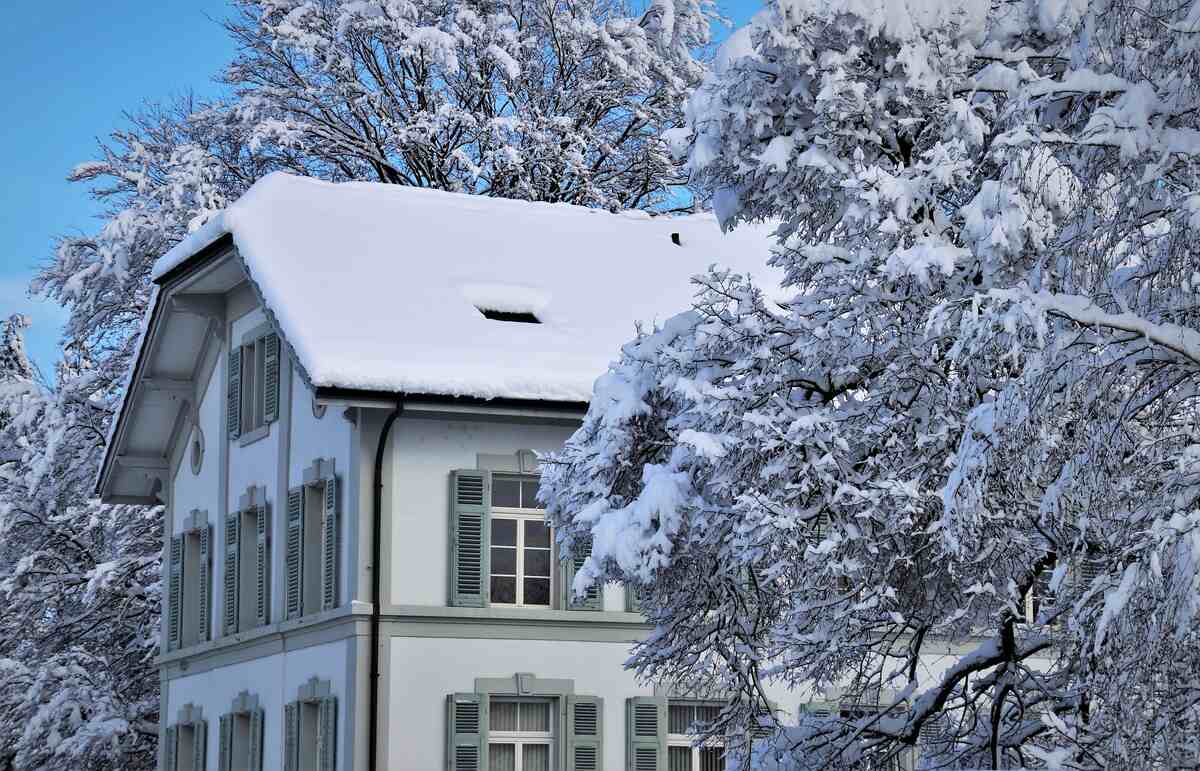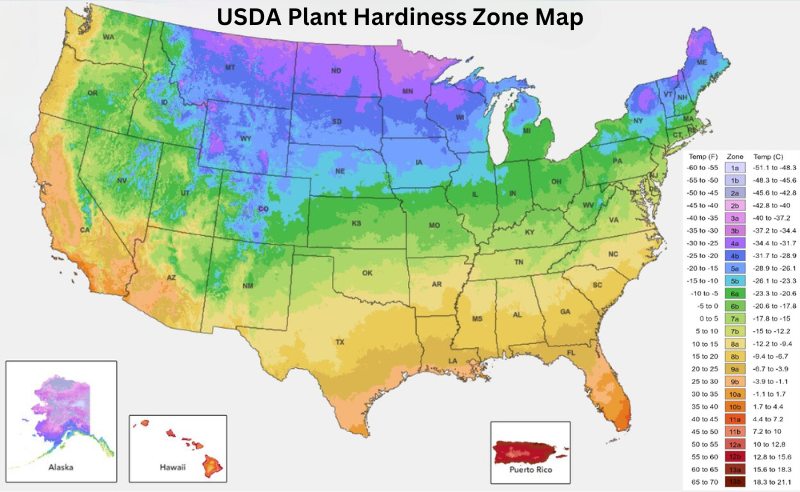
When it gets close to wintertime, you’ll need to start thinking about protecting your trees from harsh weather. Cold air and drastic temperature changes can put your trees at risk of permanent damage. But how do you protect your trees from a freeze?
Here are some measures to ensure that your trees remain strong, sturdy, and stunning after a winter frost. There are several tree damage treatments and prevention techniques you can use to keep your trees from suffering from cold weather.
- The Difference Between Frost vs. Freeze
- Know Your Hardiness Zones
- Ways to Protect Trees From Freezing Temperatures
- Signs Your Tree is Suffering From Cold Damage
- How to Help Your Tree Recover From Cold Damage
- Which Trees are the Most Susceptible to Cold?
- FAQ About Protecting Trees From a Freeze
- When to Hire a Landscaping Pro
The Difference Between Frost vs. Freeze
Despite what you might think, frost and freeze are not the same thing. You can have a freeze without frost. A frost is when there is visible frost, while a freeze is when the air temperature drops below freezing (32 degrees F).
A light freeze happens between 29 degrees F and 32 degrees F and can kill tender plants. A moderate freeze occurs between 25 degrees F and 28 degrees F and is widely destructive to most vegetation, while a severe or hard freeze is lower than 25 degrees F and causes heavy damage to most plants.
A frost advisory is announced when temperatures are expected to fall between 36 degrees F and 32 degrees F, while a freeze warning is issued when there is at least an 80 percent chance the temperature will fall below 32 degrees F.
Damage to plants occurs when one of two types of freezing or frost events happen:
Radiational frost or freeze happens on clear nights when the heat rises into the atmosphere and leaves surfaces colder.
Advective frost or freeze is when a cold air mass moves in, creating a sudden drop in temperature.
Know Your Hardiness Zones

The USDA Plant Hardiness Zone Map determines which plants are most likely to thrive and survive in a location. The map is divided into 13 zones based on the average annual minimum winter temperature, divided into 10-degree F zones.
The hardiness of your trees depends on your location. You can locate where you live on the map to determine your hardiness zone. Any plants or trees you buy at your local garden center or nursery will have a tag on them listing their hardiness zone.
Ways to Protect Trees From Freezing Temperatures

Cover Trees
Cover your tree whenever the temperature is expected to drop below 32 degrees Fahrenheit. To trap in the earth’s accumulated warmth, drape young or small trees with burlap, sheets, or tarps that extend to the ground, and use a frame or stakes to reduce contact between the cover and the leaves of the tree. You can keep the covers in place with twine or clothespins.
You also can wrap the trunk of the tree with a plastic tree guard or any other opaque protective tree wrap to protect it from sunscald. Another effective insulation method is to bank clean soil a foot or two high on the trunk.
Keep Trees Watered

Running sprinklers at the coldest time of the day makes use of latent heat released when water changes from liquid to solid. The moist soil absorbs more solar radiation than dry soil and will emit heat during the night.
Remove Weeds and Turf
Since bare soil is the most effective at absorbing and reflecting heat, you should remove weeds and turf from under your tree canopy.
Mulch for Insulation

A 1-2 inch layer of mulch around the base of your tree in a diameter of at least 3 feet will prevent soil moisture loss and insulate the roots. Wood chip mulch is the most effective. Remember not to pile the mulch up around the trunk of the tree. Too much moisture increases the risk of insects, fungi, and other pests.
Heat Lamps
In extreme cases, heat lamps with a 100-watt bulb can keep trees warm, especially if placed under a cover to protect saplings. However, this risks burning the tree, so be careful that the lamp does not touch the plant. If a single bulb is unavailable, you also can use strings of Christmas lights.
Signs Your Tree is Suffering From Cold Damage
Leaves
Winter Burn
The foliage on an evergreen tree will become brown or bleached out for a few different reasons during the winter. The winter sun and wind can cause the tree to lose water that its frozen roots can’t replenish, or the rapid changes to the temperature when the sun is down can injure or kill the foliage.
How to Protect: There isn’t much you can do to prevent or repair foliage discoloration, but you can attempt to block out the harsh winds with burlap or pine boughs.
Roots
Frost Heaving
The soil repeatedly freezing and thawing in cold weather causes soil to expand and contract, damaging roots and heaving new trees out of the ground.
How to Protect: You can prevent heaving and maintain more constant soil temperatures with a 4- to 6-inch layer of mulch.
Root Injury
Roots of most trees and shrubs die at temperatures below 10 degrees Fahrenheit because soil temperatures are much higher than air temperatures, and soil cools more slowly than the air temperature. Roots are less hardy than stems and do not become dormant in the winter as quickly as stems, branches, and buds.
How to Protect: Cover the roots of newly planted trees with 3 to 4 inches of mulch and keep the mulch about 6 inches away from the trunk. Water heavily to reduce frost penetration and fill cracks in the soil around new plants with more soil.
Limbs
Broken Limbs

Heavy snow and ice storms cause damage by bending and breaking branches. The most susceptible trees are evergreens and trees with multiple stems or narrow branches.
How to Protect: You should wrap small trees together with strips of carpet, strong cloth, or nylon stockings, but remember to remove the wrappings in the spring to allow free movement of the stem. You also will need to maintain proper pruning to eliminate multiple leaders and weak branches, reducing snow and ice damage. A professional arborist should cable the main branches together for large, multi-stemmed trees.
Dieback
Deciduous trees and shrubs can suffer shoot dieback and bud death during the cold winter.
How to Protect: There isn’t much tree care you can do to prevent this from happening. Just don’t go overboard with pruning, fertilizing, or watering your trees during the late summer.
Bark
Frost Cracks
The repeated fluctuating temperatures can cause the inner layers of bark to expand and shrink over and over and eventually crack. Frost cracks likely won’t kill your tree, but they do invite insects and disease.
How to Protect: The only thing you can do is leave your tree alone during its healing process and proactively fertilize it in the spring to support and encourage new growth.
Sunscald

Sunscald happens when there are cracked areas of dead bark, which the sun heats up on cold winter days to stimulate activity. When something blocks the sun, the temperature will rapidly drop and kill active bark tissue. The result is a discolored, sometimes sunken, area of bark on the southwest-facing side of the tree.
Young trees, newly planted trees, and thin-barked trees such as cherry, crabapple, honey locust, linden, maple, mountain ash, and plum are prone to sunscald.
How to Protect: You can prevent sunscald by wrapping the trunk with white guards to reflect the sun and keep the bark at a constant temperature.
How to Help Your Tree Recover From Cold Damage
Avoid Pruning
Do not immediately prune and wait to see what sprouts in the spring. The damage is often not as bad as it looks at first glance, and new growth may sprout from tissue that initially appeared to be dead. You should remove any mushy, frosted fruit from your trees.
Whitewash
If your tree has severely lost shade, you can protect the unshaded portions of the tree trunk and branches from the sun with either a physical cover (tarp, burlap, sheets, plastic sheeting) or whitewash – a type of paint made from slaked lime and chalk.
Repair Sunscald
You can use a sharp, sterilized knife to remove dead tree bark affected by sunscalding. Round off the sharp corners to help your tree heal. Leave the wound open and uncovered, and don’t apply any paint or tar to the spot. Spray the wound with fungicide if you’re treating a tree that is susceptible to fungus.
Which Trees are the Most Susceptible to Cold?

Tropical, subtropical, and fruit trees are likely to sustain frost damage. Young, newly planted trees are also easily injured by freezing temperatures.
Here are some of the most cold-sensitive trees:
- Citrus
- Catalpa
- Jacaranda
- Oleander
- Eugenia
- Palm Trees
- Slash Pine
- Longleaf Pine
FAQ About Protecting Trees From a Freeze
Healthy, well-established trees should recover and produce additional growth within a few weeks.
You can tell if the tree is dead by scratching away the bark in late winter. If the material is green underneath, then the tissue is still alive. If the bark has begun to crack and flake off, and the underneath is brown and dry, then the tissue is dead.
Trees enter a dehydrated, dormant state to survive the winter since less water means less expansion when freezing. Some trees produce more sugar in preparation for winter, and when the sugar dissolves in the water, it lowers the water’s freezing point and acts as a natural antifreeze.
When to Hire a Landscaping Pro
If you’re not confident in your ability to take care of your trees during the freezing winter months or just would just rather be inside with a mug of hot cocoa, then you might be happier hiring a reliable landscaping pro instead.
If you need someone experienced to handle all of your tree, shrub, and lawn maintenance needs, check out Lawnstarter’s extensive list of landscaping contractors in your area.
Main Image Credit: Pixabay




